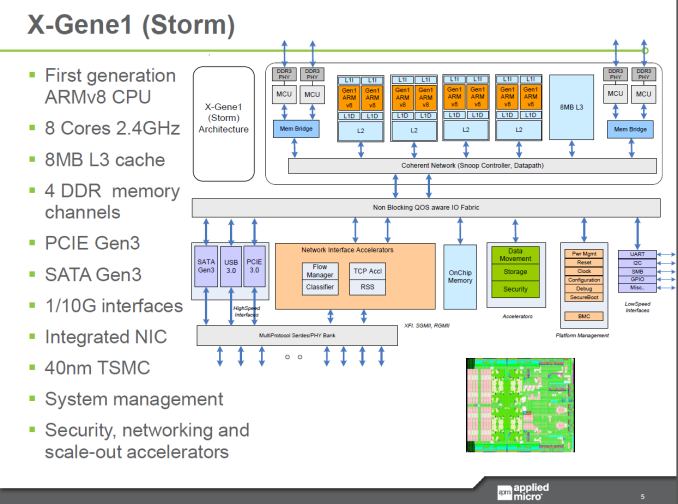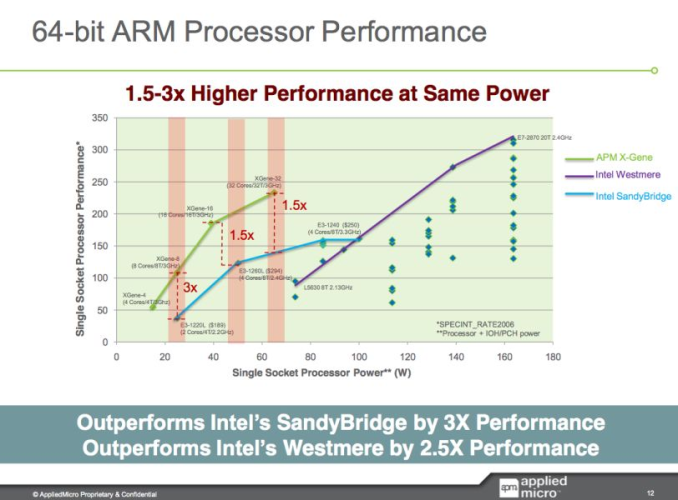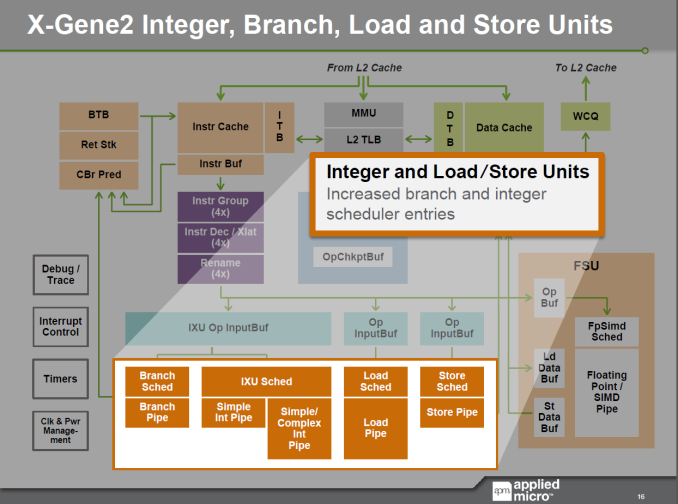ARM Challenging Intel in the Server Market: An Overview
by Johan De Gelas on December 16, 2014 10:00 AM ESTThe ARM Based Challengers
Calxeda, AppliedMicro and ARM – in that order – have been talking about ARM based servers for years now. There were rumors about Facebook adopting ARM servers back in 2010.
Calxeda was the first to release a real server, the Boston Viridis, launched back in the beginning of 2013. The Calxeda ECX-1000 was based on a quad Cortex-A9 with 4MB L2. It was pretty slow in most workloads, but it was incredibly energy efficient. We found it to be a decent CPU for low-end web workloads. Intel's alternative, the S1260, was in theory faster, but it was outperformed in real server workloads by 20-40% and needed twice as much power (15W versus 8.3 W).
Unfortunately, the single-threaded performance of the Cortex-A9 was too low. As a result, you needed quite a bit of expensive hardware to compete with a simple dual socket low power Xeon running VMs. About 20 nodes (5 daughter cards) of micro servers or 80 cores were necessary to compete with two octal-core Xeons. The fact that we could use 24 nodes or 96 SoCs made the Calxeda based server faster, but the BOM (Bill of Materials) attached to so much hardware was high.
While the Calxeda ECX-1000 could compete on performance/watt, it could not compete on performance per dollar. Also, the 4GB RAM limit per node made it unattractive for several markets such as web caching. As a result, Calxeda was relegated to a few niche markets such as the low end storage market where it had some success, but it was not enough. Calxeda ran out of venture capital, and a promising story ended too soon, unfortunately.
AppliedMicro X-Gene
Just recently, AppliedMicro showed off their X-Gene ARM SoCs, but those are 40nm SoCs. The 28nm "ShadowCat" X-Gene 2 is due for the H1 of 2015. Just like Atom C2000, the AppliedMicro X-Gene ARM SoC has four pairs of cores that share an L2 cache. However, the similarity ends there. The core is a lot beefier and it features 4-wide issue with an execution backend with four integer pipelines and three FP pipelines (one 128-bit FP, one Load, one Store). The 2.4GHz octal-core X-Gene also has a respectable 8MB L3 cache and can access up to four memory channels, with an integrated dual 10GB Ethernet interface. In other words, the X-Gene is made to go after the Xeon E3, not the Atom C2000.
Of course, the AppliedMicro chip has been delayed many times. There were already performance announcements in 2011. The X-Gene1 8-core at 3GHz was supposed to be slightly slower than a quad-core Xeon E3-1260L "Sandy Bridge" at 2.4GHz in SPECINT_Rate2006.
Considering that the Haswell E3 is about 15-17% faster clock for clock, performance should be around Xeon E3-1240L V3 at 2GHz. But the X-Gene1 only reached 2.4GHz and not 3GHz, so it looks like an E3-1240L v3 will probably outperform the new challenger by a considerable margin. The E3-1230L (v1) was a 45W chip and the E3-1240L v3 is a 25W TDP chip, and as a result we also expect the performance/watt of an E3-1240L to be considerably better. Back in 2011, the SoC was expected to ship in late 2012 and have two years lead on the competition. It turned out to be two months.
Only a thorough test like our Calxeda review will really show what the X-Gene can do, but it is clear that AppliedMicro needs the X-Gene2 to be competitive. If AppliedMicro executes well with X-Gene2, it could get ahead once again... this time hopefully with a lead of more than two months.
Indeed, early next year, things could get really interesting: the X-Gene2 will double to the amount of cores to 16 (at 2.4GHz) or up the clock speed to 2.8GHz (8-cores) courtesy of TSMC's 28nm process technology. The X-Gene2 is supposed to offer 50% more performance/watt with the same amount of cores.
AppliedMicro also announced the Skylark architecture inside X-Gene3. Courtesy of TSMC's 16nm node, the chip should run at up to 3GHz or have up to 64 cores. The chip should appear in 2016, but you'll forgive us for saying that we first want to see and review the X-Gene2 before we can be impressed with the X-Gene3 specs. We have seen too many vendors with high numbers on PowerPoint presentations that don't pan out in the real world. Nevertheless, the X-Gene2 looks very promising and is already running software. It just has to find a place in a real server in a timely fashion.














78 Comments
View All Comments
hojnikb - Tuesday, December 16, 2014 - link
Wow, i have never motherboard that simple :)CajunArson - Tuesday, December 16, 2014 - link
OK you devote another huge block of text to the typical x86 complexity myth* followed by: Oh, but the ARM chips are superior because they have special-purpose processors that overcome their complete lack of performance (both raw & performance per watt).Uhm... WTF?? I need to have a proprietary, poorly documented add-on processor to make my software work well now? How is that a "standard"? How is requiring a proprietary add-on processor that's not part of any standard and requires boatloads of software cruft working in a "reduced instruction set architecture" exactly?
I might as well take the AVX instruction set for modern x86... which is leagues ahead of anything that ARM has available, and say that x86 is now a "RISC" architecture because the AVX part of x86 is just as clean or cleaner than anything ARM has. I'll just conveniently forget about the rest of x86 just like the ARM guys conveniently forget about all the non-standard "application accelerators" that are required to actually make their chips compete with last-year's Atoms.
* Maybe in a micro-controller setting where you are using a PIC or Arduino the x86 decoding is a real issue, but in a server? Please. Considering the only hard numbers you have show a 2013-model Atom beating a 2015-model ARM server processor, you'll have to try harder.
hlmcompany - Tuesday, December 16, 2014 - link
The article describes ARM chips as becoming more competitive, but still lagging behind...not that they're superior.Kevin G - Tuesday, December 16, 2014 - link
The coprocessor idea is something stems from mainframe philosophy. Historically things like IO requests and encryption were always handled by coprocessors in this market.The reason coprocessors faded away outside of the mainframe market is that it was generally cheaper to do a software implementation. Now with power consumption being more critical than ever, coprocessors are seen as a means to lower overall platform power while increasing performance.
Philosophically, there is nothing that would prevent the x86 line from doing so and for the exact same reasons. In fact with PCIe based storage and NVMe on the horizon in servers, I can see Intel incorporating a coprocessor to do parity calculations for RAID 5/6 in there SoCs.
kepstin - Tuesday, December 16, 2014 - link
Intel has already added some instructions in avx and avx2 that vastly improve the performance of software raid5 and 6; the Haswell chip in my laptop has the Linux software raid implementation claiming 24GiB/s raid5 with avx, and 23GiB/s raid6 with avx2 (per core).MrSpadge - Tuesday, December 16, 2014 - link
Of course additional power draw for more complex instruction deconding mattes in servers: today they are driven by power-efficiency! The transistors may not matter as much, but in a multi-core environment they add up. Using the quoted statement from AMD of "only 10% more transistors" means one could place 11 RISC cores in the same area for the same cost as 10 otherwise identical x86 cores. Johan said it perfectly with "the ISA is not a game changer, but it matters".And you completely misunderstood him regarding the accelerators. Intel is producing "CPUs for everyone" and hence only providing few accelerators or special instructions. In the ARM ecosystem it's obvious that vendors are searching niches and are willing to provide custom solutions for it - hence the chance is far higher that they provide some accelerator which might be game-changing for some applications.
This doesn't mean the architecture has to rely entirely on them, neither does it mean they have to be undocumented. The accelerators do not even have to be faster than software solutions, as long as they're easy enough to work with and provide significant power savings. Intel is doing just that with special-purpose hardware in their own GPUs.
And don't act as if much would have changed in the Atom space ever since 22 nm Silvermont cores appeared. It doesn't matter if it's from 2013 or 2015 - it's all just the same core.
OreoCookie - Tuesday, December 16, 2014 - link
What's with all the unnecessary piss and vinegar?All CPU vendors rely increasingly on specialized silicon, newer Intel CPUs feature special crypto instructions (AES-NI) and Quick Sync, for instance. Adding special purpose hardware to augment the system (in the past usually done for performance reasons) is quite old, just think of hardware RAID cards and video »accelerators« (which are not called GPUs). The reason that Intel doesn't add more and more of these is that they build general purpose CPUs which are not optimized for a specific workload (the article gives a few examples). In other environments (servers, mobile) the workload is much more clearly defined, and you can indeed take advantage of accelerators.
The biggest advantage of ARM cpus is flexibility -- the ARM ecosystem is built on the idea to tailor silicon to your demands. This is also a substantial reason why Intel's efforts in the mobile market have been lackluster. Recently, Synology announced a new professional NAS (the DS2015xs) which was ARM-based rather than Intel-based. Despite its slower CPU cores, the throughput of this thing is massive -- in part, because it sports two (!) 10 GBit ethernet ports out of the box. Vendors are looking for niches where ARM-based servers could gain a foothold, so they are trying a lot of things and see what sticks.
goop666666 - Saturday, December 20, 2014 - link
LOL! Most of the comments here like this one seem to be written by people who think computers should all be like gaming machines or something.Here'a tip: no-one cares about "complexity," "standardization," "RISC," or anything else you mention. All they care about in the target market for ARM server chips is price, performance and power, and I mean ALL THREE.
On this Intel cannot compete. They sell wildly overpriced legacy hardware propped up by massive R&D expenditures and they're wedded to that model. The rest of the industry is wedded to the new and cheap model. Just like how the industry moved to mobile devices and Intel stood still, this change will also wash over Intel while they sit still in denial.
There's a reason why Intel stock has gone no-where for years.
nlasky - Monday, December 22, 2014 - link
Jan 8, 2010, Intel stock price $20.83. Dec 19, 2010, Intel stock price $36.37. If by gone no-where in for years you mean increased by 70% I guess you would be correct. Intel can't compete because they are wedded to their model? They have a profit margin of 20% and an operating margin of 27%. They could easily cut prices to compete with any ARM offerings. Servers have been around forever, unlike the mobile computing platform. Intel has an even larger stranglehold on this industry than ARM has in the mobile space. Here's a tip - stop spewing a bunch of uniformed nonsense just to make an argument.nlasky - Monday, December 22, 2014 - link
*Dec 19, 2014